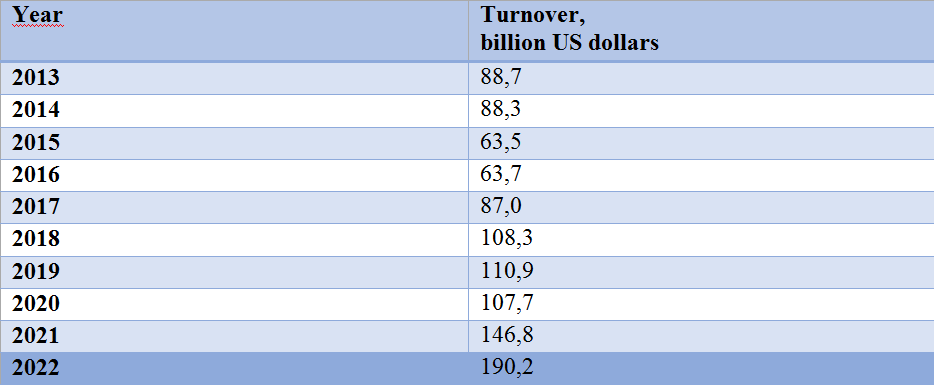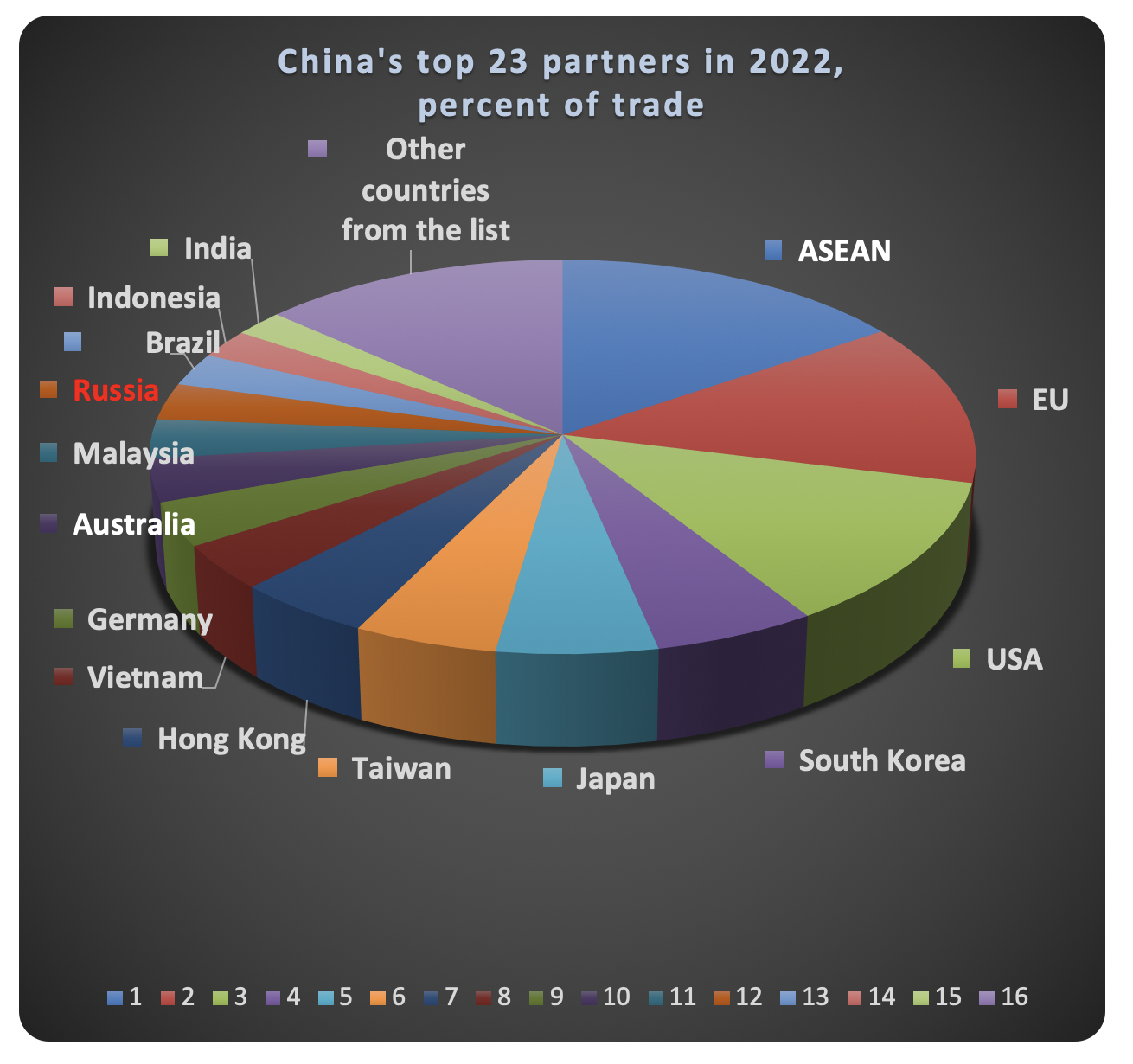For a long time there has been a process of reorientation of Russia’s trade flows from the West to the East. The Asian market is huge; it has great growth potential and the population has high purchasing power. Trade cooperation with the BRICS countries, ASEAN, the Arab countries, as well as Africa and Latin America is expanding, writes Anastasia Stepanova.
In 2018, for the first time in history, trade between Russia and China surpassed the psychologically important limit of $100 billion a year. Russian President Vladimir Putin and Chinese President Xi Jinping then set an ambitious new goal — to increase trade between the two countries to $200 billion by 2024. There is reason to believe that this goal will be successfully achieved. In just a few years, as of 2023, there has been a qualitative expansion of Russian-Chinese trade in goods and services. First of all, this growth is due to the development of joint projects in the energy sector, industry, the agricultural sector and high technology.
The development of economic relations between Russia and China is becoming increasingly important for both countries. Since the end of 2022, China has been Russia’s leading trading partner. Trade between Russia and China rose to $190.27 billion in 2022, a 29.3% rise. In 2021, the trade turnover between Russia and China amounted to $146.887 billion, which is 35.8% more than in 2020. Thus, in recent years, even despite the restrictions caused by the coronavirus pandemic in 2020-2022, we have seen consistent and rapid growth in trade between the two countries.
The same applies to both imports and exports. According to the General Customs Administration of China, in 2022 imports from Russia rose to $114.15 billion, representing a 43.4% increase in percentage terms compared to 2021. At the same time, the country’s exports to Russia increased to $76.12 billion, by 12.8%.
Table 1
Trade turnover between Russia and China, 2013-2022 .

For a long time there has been a process of reorientation of trade flows from the West to the East. This process has accelerated since 2014, after the entry of the Republic of Crimea into the Russian Federation, but since February 24, 2022, with the start of the special military operation to protect the Donbass residents, a turn to the East has become inevitable. At the same time, the Asian market is huge; it has great growth potential and the population has high purchasing power. Trade cooperation with the BRICS countries, ASEAN, the Arab countries, as well as Africa and Latin America is expanding.
Russia and China have strong trade ties that have become even stronger in recent years. China supplies almost all types of products to Russia, including not only food, but also equipment, mobile phones, and mass-produced goods. China is also consistently increasing the export of electronics, engineering products, furniture, toys, textiles, clothing and footwear. Among agricultural products, China supplies fruit and vegetables (tomatoes, cucumbers, eggplants, garlic, shallots, apples, citrus fruits) as well as fish and seafood (sturgeon, trout, eel, tilapia, seafood cocktails and shrimp) to Russia, as well as rice, peanuts, and more. China also supplies agrochemicals, vitamin supplements and large-scale feed for the livestock industry.
Consequently, in connection with the West’s current sanctions policy against Russia, import substitution chains have expanded in various industries from Moscow’s Eastern partners, primarily from China, which has taken a leading position in exports to Russia. As noted above, this applies to machines, equipment, devices and much more. The automobile sector is developing especially rapidly in 2022-2023. Before the pandemic and before the start of the special military operation in Ukraine, Russian motorists preferred European cars, as well as cars made in the USA, Japan and South Korea. However, European, American, South Korean and Japanese companies have not resumed their activities in Russia in the same volume. The reasons include logistical problems, exchange rates, the complexity of mutual settlements, problems with the purchase of spare parts, as well as the geopolitical situation and sanctions. Some companies like General Motors and Renault have left the Russian market altogether.
Domestic cars are historically in constant demand in Russia. Demand for domestic cars has remained and has improved, and Chinese brands have appeared on the market to replace European brands.
Thus, this niche is being actively filled by domestic and Chinese brands. At the same time, Chery, Omoda, Exeed, Jac Motors, FAW, Haval, Geely, GAC and Changan became the most popular Chinese brands in Russia in 2023. With the rapid development of technology, a focus on green development, the construction of appropriate infrastructure, and the emergence of service stations, the market for electric vehicles is developing at a massive pace. Already today on the Russian market you can buy electric cars from different price categories, which are high quality and feature modern design. It should be noted, that the Russian auto industry is also actively developing e-cars like the Moskvich, Evolute, E-Neva and other brands. Particularly important in this regard is the further development of joint Russian-Chinese production in the automotive industry as a whole, rather than simply dealer networks.
Russia supplies China with energy products — oil, gas, refined products, agri-food and industrial products. Russian by-products are in great demand in China — primarily chicken feet and legs, fish and seafood, honey, alfalfa, confectionery, sunflower oil and seeds and pine nuts.
Unfortunately, despite a lengthy negotiation process, the export of Russian pork to China is still banned. Russia is also the largest timber supplier to China. In connection with the reform of legislation in the field of timber processing, since January 1, 2022, the export of roundwood (coniferous, as well as valuable hardwoods such as ash, beech and oak) has significantly decreased. According to 2022 year-end results, Russia had reduced the export of roundwood by 71% to $306 million; the export volume amounted to 3 million cubic meters.
Russia’s most significant exports to China are oil, gas, steel and coal. The volume of purchases from Chinese partners is growing steadily; however, there are some nuances. Thus, due to sanctions and the refusal of European companies to buy Russian raw materials, Russia sells raw materials at significant discounts. The Chinese buy Russian steel at discount prices. The increase in coal sales has also occurred at reduced prices.
Chinese companies, including Sinopec, Zhenhua Oil, and others, are currently buying Russian oil at a discount. However, in 2023 Russia became the largest supplier of oil to China. Saudi Arabia is in second place and Iraq is in third. In 2022, Russia was the second largest supplier of oil to China, only behind Saudi Arabia. In 2022, Russia supplied 86.2 million tonnes of oil to China.
The development of gas supplies is also a priority for cooperation. This applies primarily to the Eastern direction. Despite the refusal of Western companies to cooperate in the oil and gas sector, Gazprom continues to work on offshore fields on Sakhalin Island, including the Kirinskoye and Yuzhno-Kirinskoye fields. The domestic contractor for these fields is Rusgazshelf, again involving the AkademikChersky, a Russian pipe-laying vessel. From 2025, it is planned to start gas production at the Yuzhno-Kirinskoye field as part of the Sakhalin-3 project. It is planned to produce up to 5 billion cubic meters annually at this facility.
The supply of liquefied gas to China is also actively going on within the framework of the Yamal LNG project.
Back in 2014, an agreement was signed between the Russian company Gazprom and the Chinese company CNPC on the construction of the Power of Siberia gas pipeline and the supply of gas from Russia to China through it. Gas supplies via the Power of Siberia gas pipeline began in December 2019. After 2024, it is planned to reach the design capacity of 38 billion cubic meters annually. Within the framework of the project, the Chayandinskoye field in Yakutia and the Kovykta field in the Irkutsk region are being developed.
Thus, one of the most important incentives for the growth of trade in the coming years will be the increase in Russian-Chinese gas and oil projects.
Russia and China are consistently strengthening cooperation in many areas, including trade. For Russia, China has become a leading trading partner and in 2022, as noted above, trade turnover amounted to $190.2 billion.
Particular attention should be paid to the fact that despite the high growth in trade between Russia and China, the volume of mutual investment is at an extremely low level. China practically does not invest in Russia, compared with the Central Asian countries, where a lot has been invested.
Investment issues are not the subject of this review, but they also require a lot of attention.
At the end of 2022, according to the data of the Federal Customs Service (FCS), the top five trading partners of Russia included China (+28%), Turkey (+84%), the Netherlands (-0.1%), Germany (-23%) and Belarus (+10).Analysing the structure of trade between Russia and China, we can compare China’s trade with that of other countries.
Notably, for China, the ASEAN countries, taken together, were the largest trading partners in 2022. Below is a chart of China’s top trading partners in 2022
.

Consequently, trade with ASEAN amounted to 975.3 billion USD, followed by the EU ($847.3 billion), the United States ($759.4 billion), South Korea ($362.2 billion), and Japan ($357.4 billion). Russia ranks tenth in the list of China’s trading partners. Nevertheless, the rapid growth of trade between the countries indicates a positive trend in this direction.
An important factor that will contribute to the increase in trade between Russia and China is the improvement of the system of mutual settlements in national currencies. In this regard, the further large-scale rejection of the dollar and the euro in favour of national currencies in mutual settlements, the simplification of banking and commodity settlements between countries, and the development of the digital rouble and digital yuan will contribute to a further systematic increase in trade flows.
The solution of logistical problems is also extremely relevant — this is the modernisation of existing transport corridors, the construction of new ones within the framework of the New Silk Road and intercountry transport cooperation, as well as the further digitalisation and modernisation of transport and transport services.
Xi Jinping’s visit to Russia in March 2023 — the first since his re-election as President of the PRC and successful negotiations with President of the Russian Federation Vladimir Putin — is rightfully seen as a landmark. It outlined new vectors of cooperation and long-term strategic partnerships between the two states. There are also great prospects in the trade sector.
Thus, taking into account the change in the regional structure of import-export operations and the pivot to the East, the differentiation of commodity flows (through the maintenance and further increase of mutual cooperation between Russia and China in many areas), and the stability of the political systems of both countries, in the coming years there is a clear upward trend in turnover to $300 billion.
There is a high potential for Russia in the development of export-import operations, both within the Eurasian Economic Union and with the countries of Central Asia, the Arab countries, ASEAN, Latin America, Africa and others. At the same time, when developing trade with China and other Asian countries, it is necessary to take into account the issues of tariff and non-tariff barriers in order not only to expand Russian goods and raw materials abroad, but vice versa, to increase the domestic market, and create favourable conditions for domestic and foreign companies.
At the same time, a detailed analysis of the trade turnover that developed between Russia and the European Union earlier and reached $400 billion in the best of times, its reorientation to the East, as well as an analysis of the structure of trade turnover between Russia and China and its rapid growth over the past 5 years, will help identify niches to increase trade between Russia and China up to $400 billion in the longer term.



